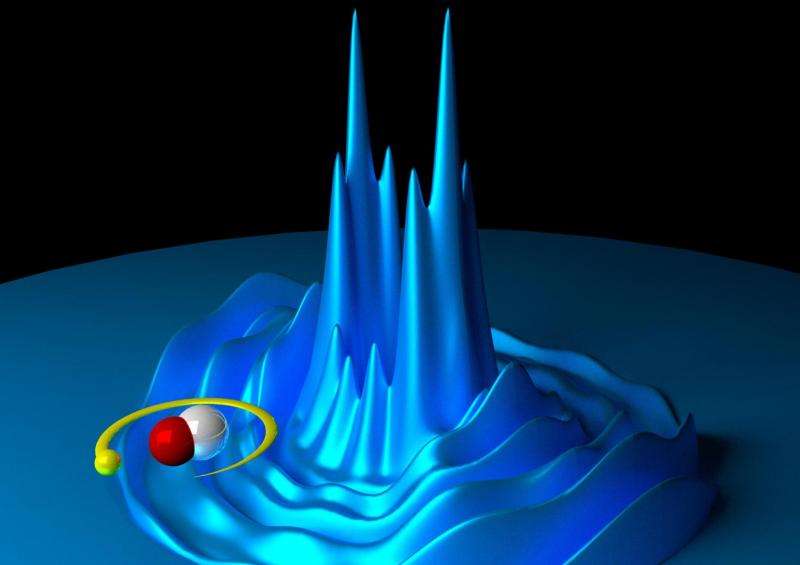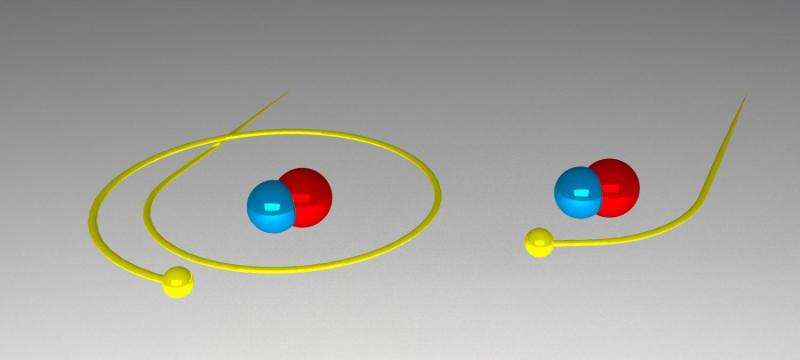Slow motion molecular collisions unravelled

For the first time, scientists have observed how molecules change direction after slow collisions with atoms. Researchers from Radboud University and the FOM Foundation allowed molecules to collide with atoms very slowly. This enabled them to zoom in on the dynamics of a collision for the first time. How do the initial conditions of particles transform into the final conditions after a collision? The results were published in the journal Science on 13 November 2015.
According to the rules of quantum mechanics, a molecule often behaves as a series of waves. When a molecule collides with an atom, many different waves play roles in the interaction. These waves interfere during the collision and can give rise to a diffraction pattern. For years, scientists have tried to map the influence of a single wave in such a collision. It is fundamentally impossible to experimentally select a single wave and study its influence on a collision process. However, at very low temperatures, when molecules collide very slowly, this becomes possible under specific circumstances—during a so-called 'scattering resonance', a single wave suddenly dominates the collision process. In this case, it becomes possible to study precisely how a single wave before the collision determines the wave character of the particles after the collision. This is the essence of a collision at the most fundamental level: How do the starting conditions of particles transform into the final conditions after a collision?
Resonant collision influences subsequent flight direction
"We can now determine this by measuring the change in the molecules' flight direction during slow collisions," says FOM workgroup leader Bas van de Meerakker, whose awards include an ERC Starting Grant in 2013. "When the molecules collide slightly too quickly or too slowly, we observe a normal diffraction pattern of waves. However, if they have exactly the right velocity and hit a resonance, the change in direction is suddenly very different. A resonance can be conceived as a collision in which the particles briefly orbit around each other before separating and flying off in entirely different directions." The experimental measurements agree exactly with quantum mechanical calculations made by theoretical chemists Gerrit Groenenboom and Ad van der Avoird, co-authors of the article. With their theory, the researchers can now precisely determine which waves play a role during a scattering resonance and how these waves influence the molecules' change in flight direction.

The Cold and Controlled Collisions laboratory at Radboud University has a Stark decelerator that the researchers can use to precisely control the velocity of the molecules before a collision. After a collision, they can accurately record the molecules' change in flight direction using the velocity map imaging method. This combination of techniques is only available at Radboud University. Thanks to this unique experiment, the researchers were able to observe these changes in the molecules' flight direction during a scattering resonance for the first time.
Quantum for kids
Van de Meerakker received a Radboud Science Award in September 2015. This prize is awarded to the three best, most important and most fascinating scientific research results of Radboud University and Radboudumc during the past year. The awards ceremony is organised by the Science Hub Radboud University Nijmegen. The winners of the awards are given the opportunity to translate their research into activities for 10- to 12-year-old primary school pupils. With the help of experiments, Van de Meerakker will introduce the children to the fascinating world of quantum mechanics, including the wave character of matter.
More information: Publication: Imaging resonances in low-energy NO-He inelastic collisions, Sjoerd N. Vogels, Jolijn Onvlee, Simon Chefdeville, Ad van der Avoird, Gerrit C. Groenenboom, Sebastiaan Y.T. van de Meerakker, Science, 13 November 2015.
Journal information: Science
Provided by Fundamental Research on Matter (FOM)





















